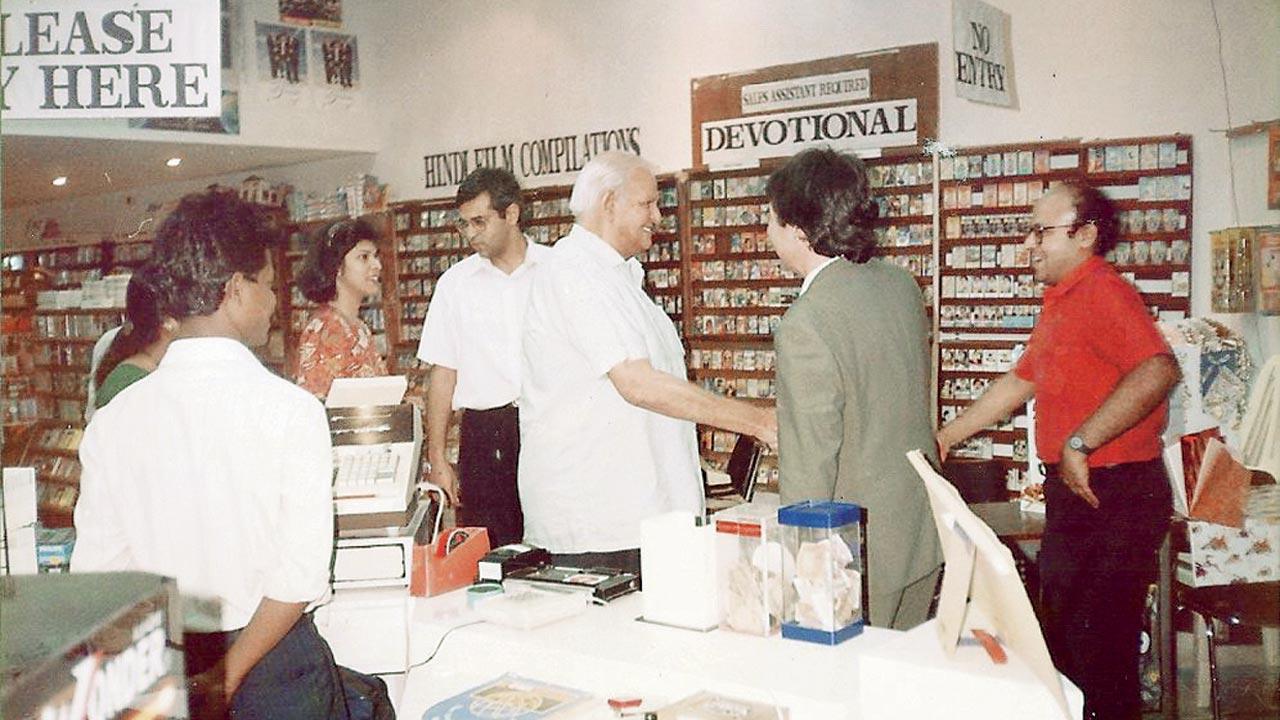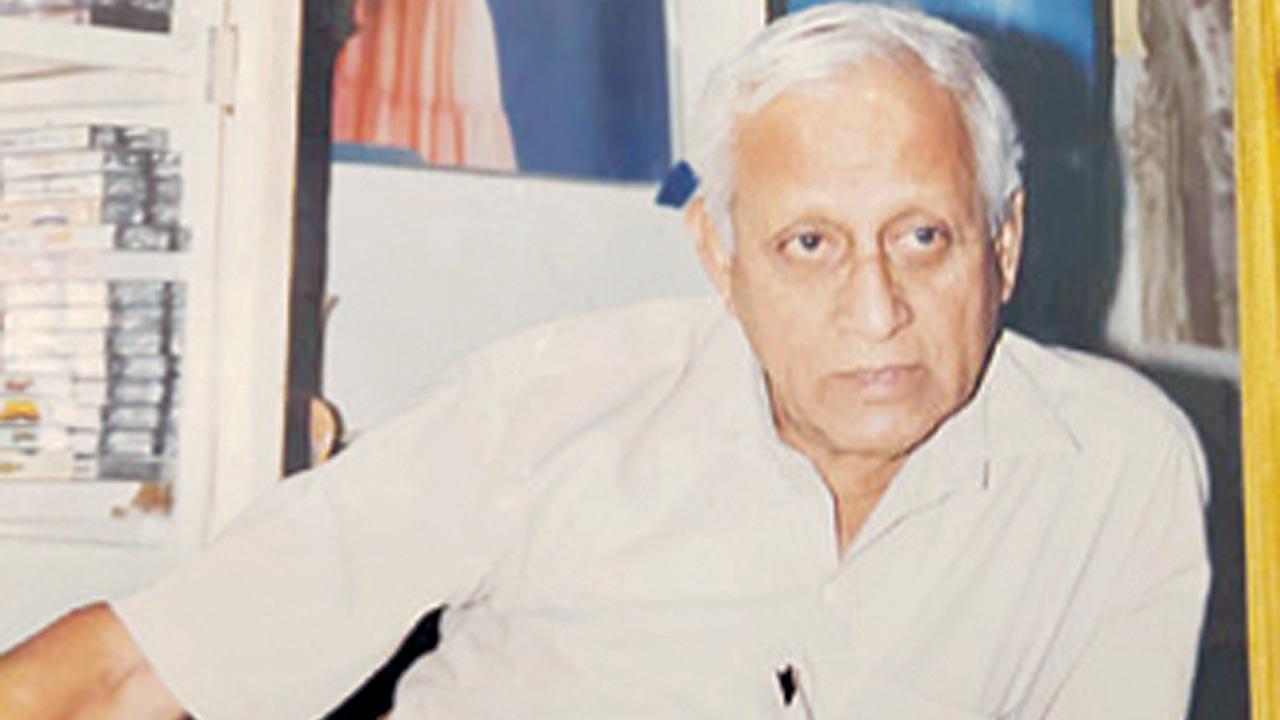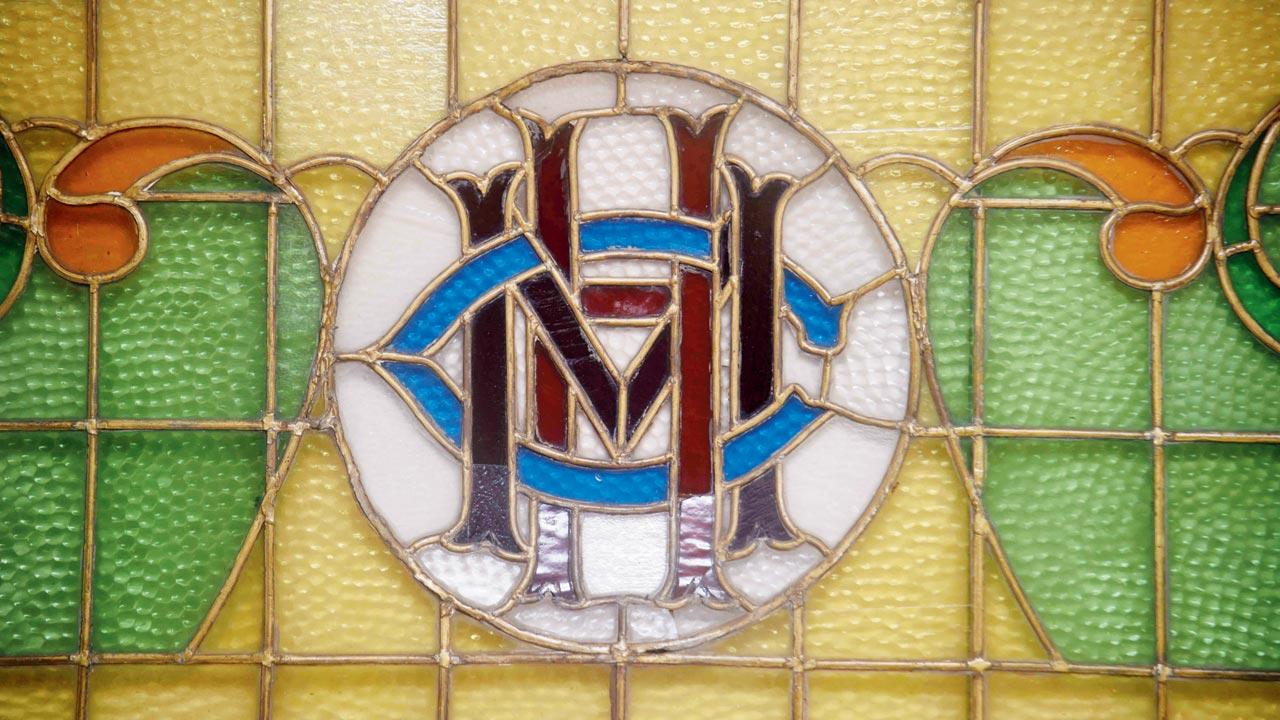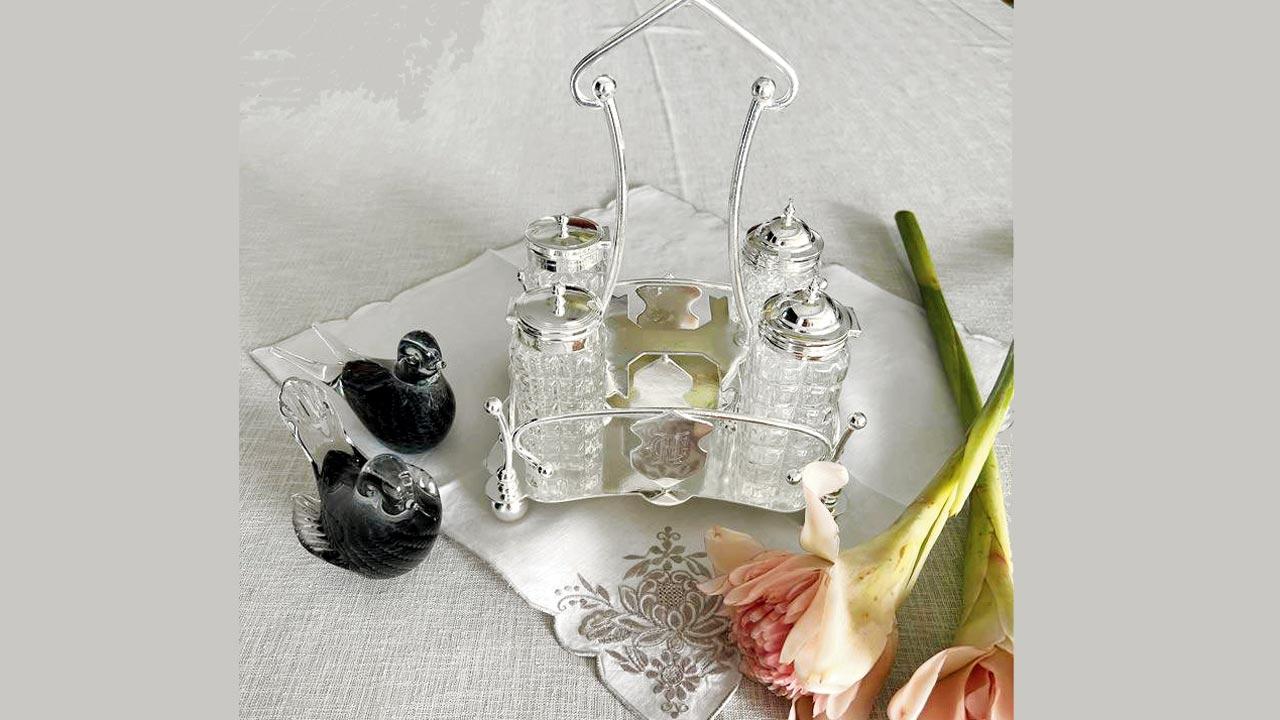Bombay bonds team tight in reassuring ways in a landscape distorted with rapidity and rapacity

Mammoo Curmally at Rhythm House with HMV and EMI personnel, his son Mehmood and daughter Farzana
 Call it symbiosis or plain dependency, gathering around food, faith and entertainment always knits people familiarly close.
Call it symbiosis or plain dependency, gathering around food, faith and entertainment always knits people familiarly close.
Without a doubt, tangy treats on Bombay streets light up everyone’s earliest years. Which of us has not indulged in some serious feasting at juice joints and chaat carts trundling not only through our childhood but across generations too?
Filmmaker Rafeeq Ellias, whose grandfather’s popular haberdashery, Amir Store, was located on midtown Clare Road, relates how a happy complicity unfolded between the pyaaliwala from Azamgarh and Johnny sherbetwala from Kerala. The former scooped passersby a delectable, over-spiced liver and potato masala mixed in kokum juice, garlic oil, mirchi and chutney. His fiery concoction naturally led school kids desperately gasping to the cool melon drink Johnny was famous for.
 Curmally’s friend Abraham Moses, proprietor of 1940s-established Our Musical Salon
Curmally’s friend Abraham Moses, proprietor of 1940s-established Our Musical Salon
Twinning their trades with motives as purposeful, a chanawala and golawala off Hill Road in Bandra worked brilliantly in tandem. Aspiring to Mahableshwar heights, the simple gram seller decided to up his act by adding fresh varieties of tongue-hang-hot masala chana. The golawala promptly froze crushed ice in a range of sweet flavours wider than the half-dozen already on array and welcomed the deliberately driven stream of customers.
My favourite account of a loyal liaison like few others, comes from photographer Hemant Chaturvedi’s description of his college days. “Walking towards St Xavier’s from my Marine Lines bus stop, the last road to cross was the side lane adjacent to the campus premises. Two peanut sellers sat on opposite sides and reminded me of a curious pair of human gateposts you went through before entering college. Those vendors passed away by the time I shot my St Xavier’s portraits project, as had the elder sandwich gentleman. So had the old man with the small bhajia stall next to the second exit gate and the nimbu paniwala.

“I wanted to include them in my series. The peanut hawkers were at that corner right from 1943 to 2010. After one died, the other stopped coming. Best friends from Borivli, they apparently travelled together daily for 67 years. At the end of every day, they would split their earnings equally. The sugarcane juice guy passing on this information [confirmed by the sandwich man] was also the repository for all keys lost by students up and down the road. Missing mine thrice, I found them with him every time.”
Extending Chaturvedi’s touching tale of camaraderie to a considerably more ambitious business… Our Musical Salon was opened at Star Mansion on Clare Road in the 1940s by MA Moses, whose wife Sheba was a familiar sight at the shop counter. Their affable son Abraham kept track of individual tastes of hundreds of regular patrons. Special Christmas mailers contacted a broad customer base of Nagpada Jews, Mazagaon Catholics and Cantonese Chinese, besides the Byculla Bohris, Anglos and Europeans. “My father ordered 500 LPs when ’70s groups like ABBA and Boney M were raging hits,” says Abraham Moses’ son Razon, of the decade he trained in the enterprise. “Dad had a terrific rapport with music dealers like the Curmallys of Rhythm House. Though competitive, these stores willingly shared stocks when the other’s ran out.”
 Stained-glass window with the Colah family crest and the matching cruet caddy reunited with it
Stained-glass window with the Colah family crest and the matching cruet caddy reunited with it
On the stretch of Raja Ram Mohan Roy Road, facing Charni Road Station, which leads into the pulsing heart of Girgaum, or Girgaon—derived from “giri”, or hill, and “gaon” at the foot of Malabar Hill—I have been struck by similarly entwined sentiments. Echoing ideals thread together the stories of origin of two companionably situated icons at the lane’s west end: Golden Star Thali and Allbless Baug.
Golden Star was a basic bun-maska and kheema-pao joint before serving thalis, we are informed by Zia Eshraghi, whose father Aziz came to town as a 13-year-old from Yazd in 1934. Waiting tables at this cafe, he worked his way up to own it in his 50s. The Eshraghis being Bahai proprietors, the restaurant alludes to the nine-pointed star symbolising a pervasive brotherhood their faith propagates. The whole number nine a perfect culminating digit, each star tip hails nine different messiahs, unanimous in preaching justice and universal peace.
 Alam Ara poster. Pic courtesy/Wikicommons
Alam Ara poster. Pic courtesy/Wikicommons
A few feet on, one reaches the entrance of a Tuscan villa-style venue laying out rich Parsi cuisine on long tables at weddings and navjotes. Allbless Baug, indeed designed in 1868 by an Italian architect, was contracted to Jamasji Mistry who built tracts of the city’s financial district. Its construction, at the then lavish cost of Rs 1,50,000, was undertaken by the sons of Edulji Faramji Allbless. Edulji Faramji earned the last name for his kind manner of greeting everyone—“God bless you all” —compressed to Allbless.
Speaking of Bombay benefactors, I recall a rather moving reflection of philosophy and emotion within the gates of Rustom Baug, which has an arresting logo emblazoned on its buildings. “In Deo Fide Et Perseverantia (Faith in God and Perseverance)” circles the hand holding a hammer symbol of industry—registered trademark of the company, Nowrosjee Wadia & Sons.
The striking image caught my eye when I interviewed theatre doyen Dinyar Contractor. Searching for his block, I stared at a sight mirrored directly under the Latin-phrased emblem. An old lady with opaquely thick spectacles under her scarf-covered head sat multi-tasking at her ground-floor window. She chanted prayers softly, while she tried, with focus and patience, to thread a needle for the chintzy embroidery frame lying on her lap. A picture of piety and perseverance exhorted by the motto just above her head, she equally evoked the seamstress skills of Jerbai Wadia, who constructed the baug in memory of her son Rustom.
A successful professional partnership sprang spontaneously in an unlikely space. The year after Imperial Movietone released India’s first talkie, Alam Ara, the “picture palace” we know as Palace Cinema in Byculla, was unveiled in 1932, by film distributor MB Billimoria and BD Bharucha, a chemist who was fed up with his job at Kemp & Co. In a strange way to get introduced, the men met while they were praying at the Bhikha Behram well at Churchgate, revered as holy by Parsis.
How beautifully better teaming works, especially when random scattered parts fuse to form a whole by complete chance. Our column on Club Road at Bombay Central printed the photo of a stained-glass window with the family crest of the Colahs who once lived on Club Road. In April 2020, Monal Jhaveri stumbled on this article while browsing the internet. “The initials in that photograph were very familiar,” she says. “Pondering, I was taken back in time to the late ’70s-early ’80s. Those were my college days when I often aimlessly wandered the narrow by-lanes of Chor Bazar, spending pocket money on curios. One vendor gave me an EPNS sauce-condiment caddy which had the same family initials etched on the crest. I never used it, so it lay in storage. Grateful for the precious family heirlooms [some dating over 150 years, many of them with monograms] blessing my home, I instantly knew I’d like to give this cruet stand to the Colahs.”
She emailed me. I put her in touch with Goolloo Colah, who was expectedly happy at the sudden reunion of these ancestral objects. “I do remember the cruet stand but have no idea why none of us took it,” she said. As soon as lockdown rules relaxed, on her first outing, en route to her brother’s place for Sunday lunch, Jhaveri dropped off the stand with its cut-glass bottles, to Colah. “I’m glad the caddy was with me for more than four decades and gladder still that I could give it to back to the family it belongs to. The rest, as they say, is serendipitous history,” says Jhaveri.
A sanguine history keeps safe the Vitthal temple, cheek by jowl beside the Hazrat Gaitan Shah Peer Rehmatullah dargah on Mori Road in Mahim. In these days of digging and finagling to “prove” whether mandir or masjid ought to occupy a site, the tiny sister shrines rest clasped in serene embrace. Nestled contiguous in the protective shade of an ancient banyan tree, they celebrated a joint centenary five years ago. When the same phoolwala strung flowers to offer at the shrines and the same chaiwala supplied tea to worshippers bowing before both.
Exemplifying grace amid gore, this sacred spot was surprisingly spared the worst communal violence which erupted in 1992-93, when blood spilled from savagely hatched pogroms. After all, the name Mahim, adapted from Mahimavati, does mean “miraculous” in Sanskrit.
Author-publisher Meher Marfatia writes fortnightly on everything that makes her love Mumbai and adore Bombay. You can reach her at meher.marfatia@mid-day.com/www.meher marfatia.com
 Subscribe today by clicking the link and stay updated with the latest news!" Click here!
Subscribe today by clicking the link and stay updated with the latest news!" Click here!










